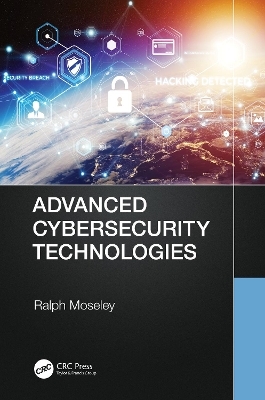
Advanced Cybersecurity Technologies
Seiten
2021
CRC Press (Verlag)
978-0-367-56227-4 (ISBN)
CRC Press (Verlag)
978-0-367-56227-4 (ISBN)
This book looks at the technical fields of Cybersecurity progressively, building up in layers before expanding into more advanced topics. Each area is looked at succinctly, describing the main elements and problems in each area and reinforcing these concepts with practical coding examples, questions and ideas for further research.
Cybersecurity is an extremely important area which is rapidly evolving, necessarily, to meet current and future threats. Anyone who studies within this domain requires a particular skillset and way of thinking, balancing technical knowledge and human insight. It is vital to recognize both sides of this complex area and integrate the two. This book looks at the technical fields progressively, building up in layers before expanding into more advanced topics. Each area is looked at succinctly, describing the main elements and problems in each area and reinforcing these concepts with practical coding examples, questions and ideas for further research. The book builds on an overview of basic architecture of systems and networks, setting a context for how information is vulnerable.
Cryptography is explained in detail with examples, showing the steady progress in this area over time through to the possibilities of quantum encryption. Steganography is also explained, showing how this can be used in a modern-day context through multimedia and even Virtual Reality. A large section of the book is given to the technical side of hacking, how such attacks occur, how they can be avoided and what to do after there has been an intrusion of some description. Cyber countermeasures are explored, along with automated systems of defense, whether created by the programmer or through firewalls and suchlike.
The human aspect of cyber security is detailed along with the psychology and motivations for launching attacks. Social engineering is focused on and with the various techniques looked at – revealing how an informed individual, organization or workplace can protect themselves against incursions and breaches. Finally, there is a look the latest developments in the field, and how systems, such as the IoT are being protected. The book is intended for advanced undergraduate and postgraduate courses on cybersecurity but is also useful for those studying IT or Computer Science more generally.
Cybersecurity is an extremely important area which is rapidly evolving, necessarily, to meet current and future threats. Anyone who studies within this domain requires a particular skillset and way of thinking, balancing technical knowledge and human insight. It is vital to recognize both sides of this complex area and integrate the two. This book looks at the technical fields progressively, building up in layers before expanding into more advanced topics. Each area is looked at succinctly, describing the main elements and problems in each area and reinforcing these concepts with practical coding examples, questions and ideas for further research. The book builds on an overview of basic architecture of systems and networks, setting a context for how information is vulnerable.
Cryptography is explained in detail with examples, showing the steady progress in this area over time through to the possibilities of quantum encryption. Steganography is also explained, showing how this can be used in a modern-day context through multimedia and even Virtual Reality. A large section of the book is given to the technical side of hacking, how such attacks occur, how they can be avoided and what to do after there has been an intrusion of some description. Cyber countermeasures are explored, along with automated systems of defense, whether created by the programmer or through firewalls and suchlike.
The human aspect of cyber security is detailed along with the psychology and motivations for launching attacks. Social engineering is focused on and with the various techniques looked at – revealing how an informed individual, organization or workplace can protect themselves against incursions and breaches. Finally, there is a look the latest developments in the field, and how systems, such as the IoT are being protected. The book is intended for advanced undergraduate and postgraduate courses on cybersecurity but is also useful for those studying IT or Computer Science more generally.
Dr. Ralph Moseley is a senior lecturer in computer science at Middlesex University, London. His teaching and research interests include cyber security and cryptography. His current research in this area has looked at automated cyber defence mechanisms and intelligence capture. In recent years he has acted as cyber security consultant and expert witness to many companies and organisations.
1. Introduction
2. Web and Network Basics
3. Cryptography
4. Hacking
5. Packet Analysis and Pen Testing
6. Social Engineering
7. Cyber Countermeasures
8. Incident Response and Mitigation
9. Digital Forensics
10. Special Topics: Counter Surveillance
11. Special Topics: Securing the IoT
12. Acronyms
13. Index
| Erscheinungsdatum | 08.12.2021 |
|---|---|
| Zusatzinfo | 5 Tables, black and white; 14 Line drawings, black and white; 20 Halftones, black and white; 34 Illustrations, black and white |
| Verlagsort | London |
| Sprache | englisch |
| Maße | 156 x 234 mm |
| Gewicht | 439 g |
| Themenwelt | Informatik ► Netzwerke ► Sicherheit / Firewall |
| Informatik ► Theorie / Studium ► Kryptologie | |
| ISBN-10 | 0-367-56227-8 / 0367562278 |
| ISBN-13 | 978-0-367-56227-4 / 9780367562274 |
| Zustand | Neuware |
| Haben Sie eine Frage zum Produkt? |
Mehr entdecken
aus dem Bereich
aus dem Bereich
Das Lehrbuch für Konzepte, Prinzipien, Mechanismen, Architekturen und …
Buch | Softcover (2022)
Springer Vieweg (Verlag)
34,99 €
Management der Informationssicherheit und Vorbereitung auf die …
Buch (2024)
Carl Hanser (Verlag)
69,99 €


